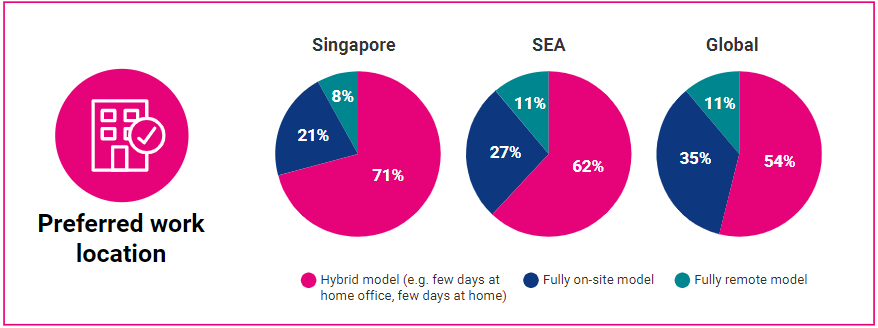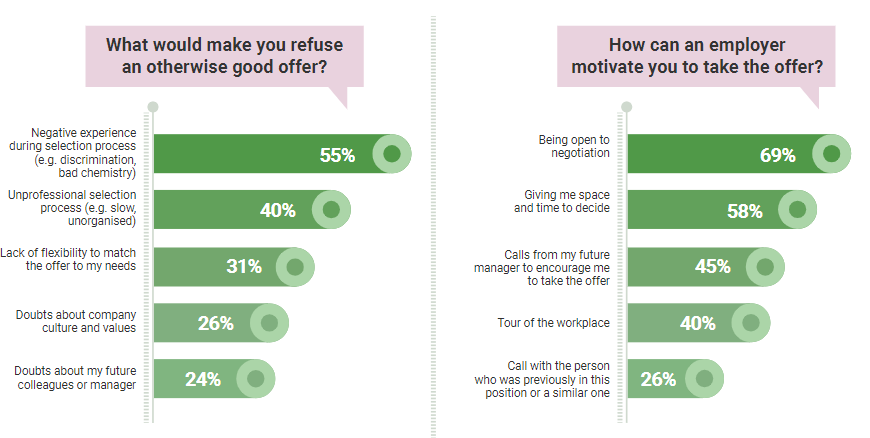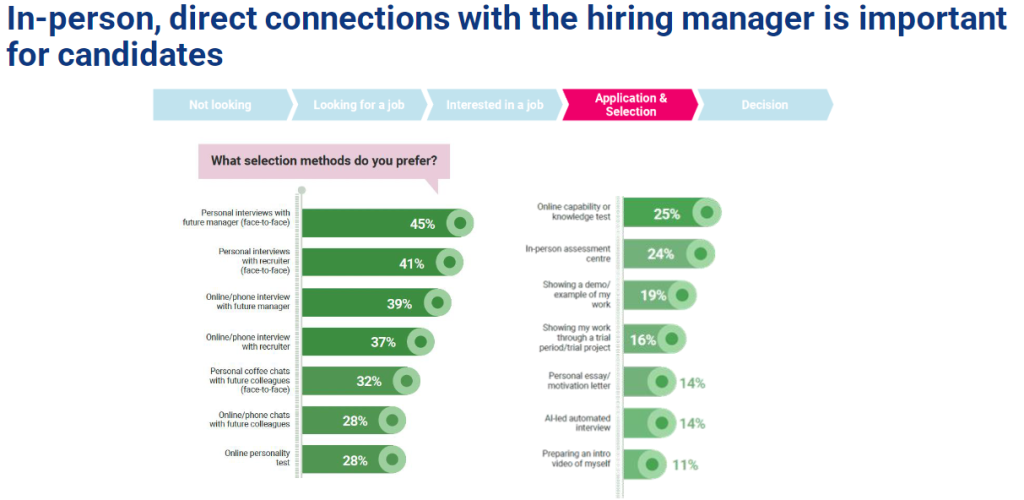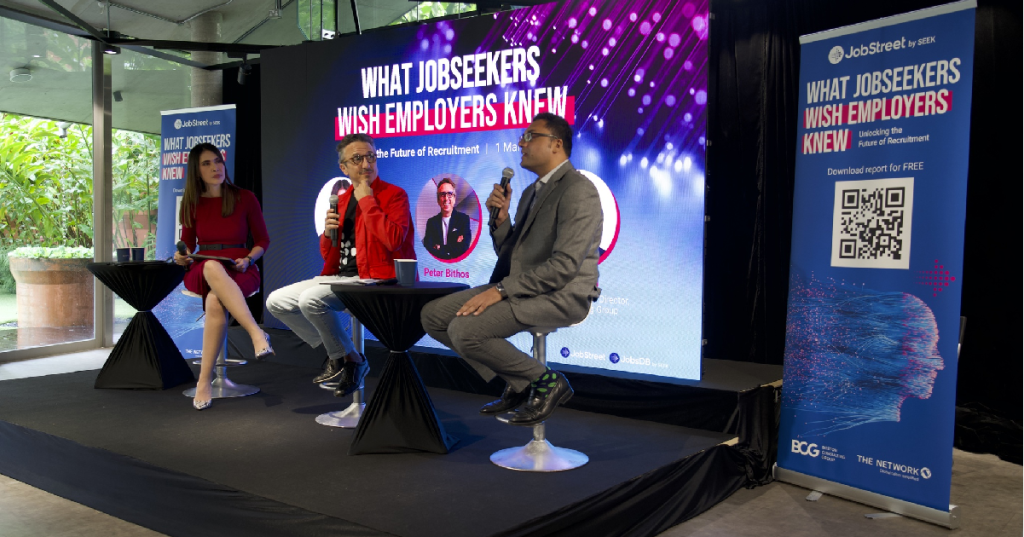Job platform JobStreet’s parent company SEEK released a new study on Wednesday (March 1) in collaboration with Boston Consulting Group, detailing changes in the labour market and employee expectations in Southeast Asia (SEA).
The study, titled “What Jobseekers Wish Employers Knew: Unlocking the Future of Recruitment”, involved a survey of over 90,000 individuals across Singapore, Malaysia, Indonesia, Thailand, the Philippines and Hong Kong.
At the launch event, CEO of SEEK Asia Peter Bithos, Partner and Associate Director of BCG Sagar Goel, and Managing Director of JobStreet Singapore Chew Siew Mee, were present to highlight several key takeaways from the report.
These are some of the key findings from their report:
- One in three people in SEA are looking for a new job, with higher salary and seniority being top reasons for making the switch.
- Talents are confident in looking for new opportunities despite global uncertainty, with 62 per cent feeling that they are in a strong negotiating position when looking for jobs.
- 71 per cent of respondents say that above all, they desire a stable job with good work-life balance.
- Advanced artificial intelligence (AI) tools being used for recruitment are not favoured amongst employees, even among the younger generation. Only 24 per cent are comfortable having an automated AI-led interview.
- 55 per cent of jobseekers would refuse an otherwise good offer if they had a negative experience during recruitment.
The makings of an employer’s market are here, but it’s still a jobseeker’s market
The study itself comes at a turning point for both employers and employees. The past few months have seen massive layoffs from tech companies like Google and Meta, while the world is gradually reopening and adapting to a ‘living with Covid’ strategy.
At the same time, there remains some uncertainty in the global economy, as fears of an upcoming recession are still very much present.
These factors, according to SEEK’s Peter Bithos, often work in favour of employers by giving them a stronger hand at the bargaining table – but not this time.
When faced with a possible recession, the balance of power in the labour market tends to shift towards employers as hiring tightens. However, we believe the situation is different this time as many organisations in Asia are still recovering from the jobs lost during the pandemic.
While hiring growth may slow down during times of uncertainty, there is no doubt that it is still a jobseekers’ market right now, and so it’s important for employers to know how to attract, recruit and retain talent.
– Peter Bithos, CEO of SEEK Asia

The study itself showed that 34 per cent of talents were actively searching for a new job, citing issues such as a desire for a more interesting position, a lack of opportunities for career progression at their current position, and dissatisfaction with salary and benefits at their current company.
Recruiters are also reaching out to those who are not actively searching for a new job, with 75 per cent of all workers indicating that they are approached multiple times a year with job offers. In sectors such as IT, talents are approached on a monthly or even weekly basis.
Employees are also more confident about negotiating the terms of their employment as well, with around 70 per cent of talents believing that they are in a strong position to negotiate for their desired salaries and benefits.
However, Bithos clarified that this did not mean that employees want to dictate their terms to employers in a ‘my way or the highway’ fashion, but are instead interested in having a discussion with potential employers about these terms.
Think twice before calling your workers back to the office
While many employers may be keen to see their workers back in the office as per pre-Covid arrangements, it seems that many employees are not too keen to return to this arrangement.
While globally, 54 per cent of workers indicated a preference for hybrid working (splitting time between working from home and working in the office), SEA – especially those from Singapore – seem to really enjoy the benefits of it.
62 per cent of Southeast Asian respondents and 71 per cent of Singaporeans preferred the hybrid model, with only 21 per cent of Singaporeans preferring to head to the office every day and eight per cent preferring to be fully remote. This, according to Bithos, signifies an important development, with some caveats.

While the days of managers walking around an office and peering over your shoulder to check if you are working or idling may be over, workers are not exactly opposed to coming into the office – they just do not want to have to do that five days a week, 10 hours a day, 52 weeks a year.
They understand the importance of meeting and interacting with colleagues, subordinates, and superiors, but they also want to be able to have the flexibility to work remotely as and when they can.
At SEEK, we’re fully hybrid now – we do set expectations that we come together sometimes, at a team level, at an office level, or sometimes at a company level. These are important rituals, but as it turns out, employees feel the same way as well.
What the statistics show is that people are saying ‘I like connectivity. I like being part of the community. I want to participate in the culture in my organisation at work. I just don’t want to be beholden to do that every day.
– Peter Bithos, CEO of SEEK Asia
At the same time, demands for work-life balance are beginning to climb the rankings of jobseekers’ priorities when it comes to deciding where to take their services.
71 per cent of survey respondents stated that above all, they desire a stable job with good work-life balance, and 17 per cent listed a lack of work-life balance as a deal breaker in accepting an offer, ranked second only to financial compensation at 22 per cent.
Hybrid working factors into this too. As Bithos pointed out, commuting to work in other countries may not be as simple as taking the MRT.
“In Singapore, hybrid working can seem like an incremental benefit. But if you’re living in Jakarta or Bangkok or Kuala Lumpur, it’s a different story. People in Jakarta can commute up to two hours a day to get to work,” he explained.
“And when you’re actually able to spend three days a week working from home, that is a material difference to your quality of life.”
It takes more than just an interview when it comes to recruiting talent
They say that an interview is a two-way street. On one hand, employers use an interview to gauge an applicant’s attitude and aptitude, while employees are offered a chance to clear any doubts that they might have about joining the company.
Yet, the report shows that for employers, the interview may begin even before the employee sits down and turns on their webcam.
A majority of candidates would reject an otherwise attractive offer if they were made to feel uncomfortable or otherwise had a negative experience during their interview.

67 per cent of respondents cited a smooth and timely process as the number one way for an employer to stand out during recruitment, and 55 per cent said that a “negative experience during recruitment” was a key reason why they refused an otherwise attractive offer.
At the same time, even the digital native younger workers are not fans of interacting with AI and recruitment bots.
Many still prefer a human touch when it comes to interviews and recruitment, with only 24 per cent of employees indicating that they would be comfortable with an AI-led automated interview.

And while some applicants appreciate being given time and space to consider their options after being offered a job, many still expect some openness to negotiate and appreciate calls from their future managers while making the decision.
What does this mean for employers moving forward?
Certainly, many of these trends may come as a surprise for many employers.
This is reflective of shifting priorities as younger members of society join the workforce, and employers risk falling behind if they do not adapt to these changing circumstances.
Employee expectations are increasingly at odds with employer expectations, but this is a situation that can be remedied. SEEK has provided several recommendations for employers on how to better cope with these changes, and come out ahead in the talent war.
Improving your job listings, getting your culture fundamentals right, and overcoming biases can increase the number of talents that are available to you, and help fill gaps that would otherwise remain.
Hiring new talents, developing existing talents, and retaining them in the long run are all important processes in maintaining the company’s talent pipeline, and in the modern day, this task is more challenging than ever.
However, this path is not one that you have to walk all alone. SEEK’s full report contains further insights as to what employees value, and what they expect, as well as recommendations on how to meet them as an employer – this can be a valuable tool in your arsenal as you navigate the increasingly difficult job of winning the talent war.
Interested readers can download the report here.
This article was written in collaboration with JobStreet by SEEK.










